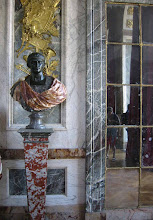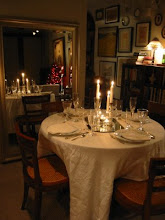If you're not familiar with Trumbauer you may be familiar with some of his work. A self-educated man, he rose to become one of the most sought after residential architects of the early 20th century. His last completed project, Rose Terrace, is the subject of this brief post.
Started in 1930 the house wasn't finished until 1934 for Anna Dodge Dillman in Grosse Pointe Farms, Michigan. While noted as a difficult woman she had amazing taste and hired (or married) the best tastemakers of her day; Trumbauer, Lord Duveen, and Alavoine & Cie, amongst others. Anna lived at Rose Terrace until her death in 1970, spending summers at her Mizner designed estate in Palm Beach, Playa Riente (not a bad life, no?).
The house was immense as you can see from the floorplans above. While Trumbauer was known mainly for large houses, this was his last and certainly his finest. Many refer to the house as the best example of French neoclassical style ever built in this country: a slight on Miramar, the Trumbauer house on which Rose Terrace was based.
Anna lived at Rose Terrace in isolated splendor especially as she descended into her twilight years; money provides an excellent buffer and she lived in a Belle Epoque splendor as the fortunes of Detroit crumbled.
Sadly the house didn't fair as well as Anna. After her death the house was unable to be sold, mainly due to the 70s recession. After a few years of neglect the contents were dispersed (mostly auctioned off although the music room resides in the Detroit Art Museum) and the house torn down. The gates now enclose a bland subdivision.
Was Rose Terrace one of the last great estates to be seen in this country? If so its ending is rather poetic as it lasted as long as Anna.
See and read more about Rose Terrace at Old Long Island and a series of fascinating videos HERE.
All images are from the aforementioned book and not the editor's own.

















































.JPG)








































































18 comments:
Wow, I didn't know about him! The story of the house is a sad one. As I am researching for a project, I am increasingly saddened that so much of our architectural heritage has been destroyed for "progress". This American drive was already evident early in the 19th century when our history was erased in NYC constantly. There is so little that remains... almost none of the great mansions are left in the city –– replaced by giant blocks. Thanks for sharing this.
This looks fantastic. Thanks for sharing.
Past - only big architecture geeks (like me!) would really know who he is. I think you would LOVE his work! I'm always saddened by whats lost but always amazed at what is still all around us, almost hiding. Do you know that blog "Daytonian in Manhattan"? He/she blogs DAILY about mansions all over NYC hidden in plain site - fascinating stuff! The link is on my blogroll - definitely check it out!
Kwana, my pleasure! Love to share what inspires me in the hopes it reaches others too.
I agree that Daytonian in Manhattan is a great source for many wonderful buildings still extant in NYC.
I do think that the Elms and Rosecliff in Newport would give Trumbauers Rose Terrace a run for the money as the best examples of French Neoclassical homes in the U.S. as well as a few others including Miramar, but it is wonderful that 3 out of 4 still are around to enjoy. The demolition of Rose Terrace and dispersal of the museum qulaity collection of antiques and art was indeed very unfortunate. Places like this and art collections like this will never again be amassed with the quality and craftsmanship that was evident here because the items are just not available.
Great blog you have and I stop by often. RT
thank you, RT! That immense fortune - TAX FREE! You just don't have that anymore - it makes people a bit more cautious with their funds, no matter what they are.
I mean -it was interesting to read the numbers. The house was built (just the building) for $4 million in 1930 - approx $65 million today! Let alone Duveen's furnishings for a mere $2 million. Who today builds a $65 million dollar house furnished with $32.5 million. Not withstanding the arguement that such quality is hard if not impossible to achieve today.
There's nothing like a good dose of Belle Epoque! The American version seems at this remove a combination of grandeur and comfort with minimal stuffiness.
I love the yacht in the last photo - perhaps almost as big as the house.
Blue, I have to agree with you that the American versions of these palaces seem to my eye to be better than their European inspiration.
There seems to be something exquisitely glamorous about being able to moor one's yacht at their doorstep!
As a Pittsburgher, you may know that the heart of early 19th century Pittsburgh was almost completely Neoclassic. Now I think there's only on Neoclassic building left there. And here in St. Petersburgh, the Mediterranean buildings of the 1920s are disappearing left and right.
Thanks for an interesting posting . . .
Wonderful. I love the arrangement of some of the guest rooms, with the attached bathrooms and closets that have curved walls/doors.
I'd love to see the plan of the basement floor, with the kitchen and, apparently, much, much more. And then the third floor for the servants, etc., the garages.... Ah, the glamorous life.
Stephilius - yes, my only problem with the book is the floorplans are only the primary floors and not service spaces. I guess I should just be glad to have what is offered!
Mark, I had no idea -haha. Pittsburgh is an awesome place. Did you hear it's rated one of the top places in the world to live this year - the only place in the USA! You can take the boy out of Pittsburgh but not Pittsburgh out of the boy!
Used to pass the gates of Rose Terrace as a kid - always very mysterious and exciting. Grosse Pointe had many, many beautiful houses that are now lost, but this was probably the biggest tragedy.
And I agree with you - this book is awesome!
I am always deeply grieved when an Architectural Treasure is razed and forever Lost in the name of Progress or as I call it, Greed and Apathy for what can never be replaced! Cookie cutter modern subdivisions cannot possibly compare and leave no Legacy for Future Generations to Enjoy.
Dawn... The Bohemian
Okay I'm just getting back to the real world and catching up on my reading. What a pleasant surprise to see a review of something that's been sitting on my wish list! Now reading the comments, you and RT bring up a point. I often wonder why one earth would anyone build that $100mil house in Orlando (the Siegels?) it never was finished and went into foreclosure in 2008 when a historic property that cost the same to build shows much more craftsmanship. if you are bored on a rainy day the documentary "queen of Versailles" is on Netflix, very sad but about the family and that Orlando house.
Here is more information.
http://apps.detnews.com/apps/history/index.php?id=97
Hi; long time reader, first time poster.
There is something about the proportions of Rose Terrace and Miramar that is just...off. They were not Trumbauer's most successful exteriors, although his interior planning was exemplary. The Elms in Newport, the James B. Duke house in Manhattan, and the current Belgium ambassador's residence in D.C. are, to my eye, some of the best French neoclassical structures standing in the U.S. today, along the Perry Belmont residence in D.C. (a Trumbauer/Sanson collaboration, although the design is Sanson's, who was probably the better architect). Speaking of Sanson, Carolands is quite a nice piece of work as well. Check out his Ferreyra commission, in Argentina, now sadly violated by incompetent "modernist" hacks who disfigured it into an art museum after the house was forcefully expropriated by the government from its recent owners, descendants of the the man who built it. And his pupil Sergent's houses there as well (the Bosch, Errazuriz, and Sans Souci "palaces.") But anyhow, I wonder how much of T's work was in reality actually attributable to his designer, Abele.
One other thing-- I adore the magnificently high ceilings in these French houses. My goodness, 18 feet, 21 feet! Throughout! It feels so good to be in spaces like that. I really don't understand why people quibble about a lack of coziness with high ceilings. It's never been an issue for me, and I in fact, prefer tall spaces. What are your thoughts on that?
-Ed
Hi Ed, thanks for the comment! Always love when people are part of the dialogue.
I agree about the proportions- they are not humanly scaled but certainly grand. I love high ceilings too as long as it's all kept proportional.
I wasn't aware of his Argentine commission -I'll have to look that up. Carolands is an amazing house, I love that book!
Post a Comment